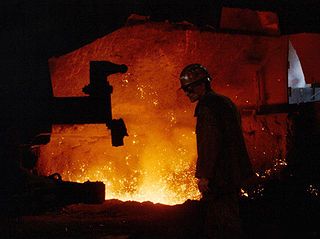From Guest Blogger Jason: How Green is My Steel Industry?

The production of steel has historically also been a very dirty process that results in numerous greenhouse gas emissions, slag waste and requires enormous amounts of energy to fire high temperature blast furnaces.
The steel industry has also been one of the greatest examples of stepping up to the plate in developing means to make the process as green as possible. As a result, the industry has seen a 50 percent decrease in energy requirements since 1975.
Numerous other improvements have resulted in an industry that is surprisingly very green.
Steel Recycling
The first example of green steel is the viability of the product for recycling. It is one of the most recycled materials in the world, according to Steel Works.
In 2012, 88 percent of all steel was recycled. Compare that to a liberal estimate of plastic recycling at only 31 percent for PET. Steel can be recycled at just about every stage of the process in production and manufacturing.
Mills can recycle their production scrap immediately, the scrap from making consumer goods can be recycled and then finally the consumer goods themselves can be recycled. Automobiles and appliances are recycled at extremely high percentages at 92.5 percent and 90 percent respectively.
Furnace Gas Power
The steel making process results in the release of many gases. On their own, most of these gases do not have an energy profile that makes them useful, but when all of the gases are trapped and mixed properly they can be used to power the furnace.
This can dramatically lessen the demand for outside energy at the steel mill. One example of a steel gas utilization concept is built by Clarke Energy.
Slag Recycling
The steel industry has found a way to make use of nearly all of its byproducts, including the solid byproducts commonly called slag.
In the past, slag waste was simply dumped in massive piles and left to sit, slowly leeching toxins into surrounding soil. The steel industry sells or donates its slag to other industries, mostly in construction.
According to Harsco, steel slag is very valuable and different types of slag have different uses, mostly as aggregates to help strengthen other materials like cement.
The Way Forward
Despite all of its advances, the steel industry now admits that it can go no further. The limitations of physics mean that the co2 emissions and energy requirements of current steel making practices cannot be reduced any further.
In order for the steel industry to continue to improve, entirely new methods of steel production must be created, and that is currently the international focus of the steel industry. More information about these projects is published by the World Steel Association.
Bringing all countries on board with clean steel production is also vital. While developed nations in North America and Europe uses the greenest methods, countries like China and India lag behind.
To compound this problem, the production of steel in China and India far outpaces production in other countries. Getting these major producers to adopt the cleaner processes will be the first major step forward for the industry.
Jason is professional blogger that is environmentally aware and believes in taking steps to protect the earth. He recommends Federal Steel Supply for all steel pipe needs as you build toward leaving a smaller carbon footprint.
